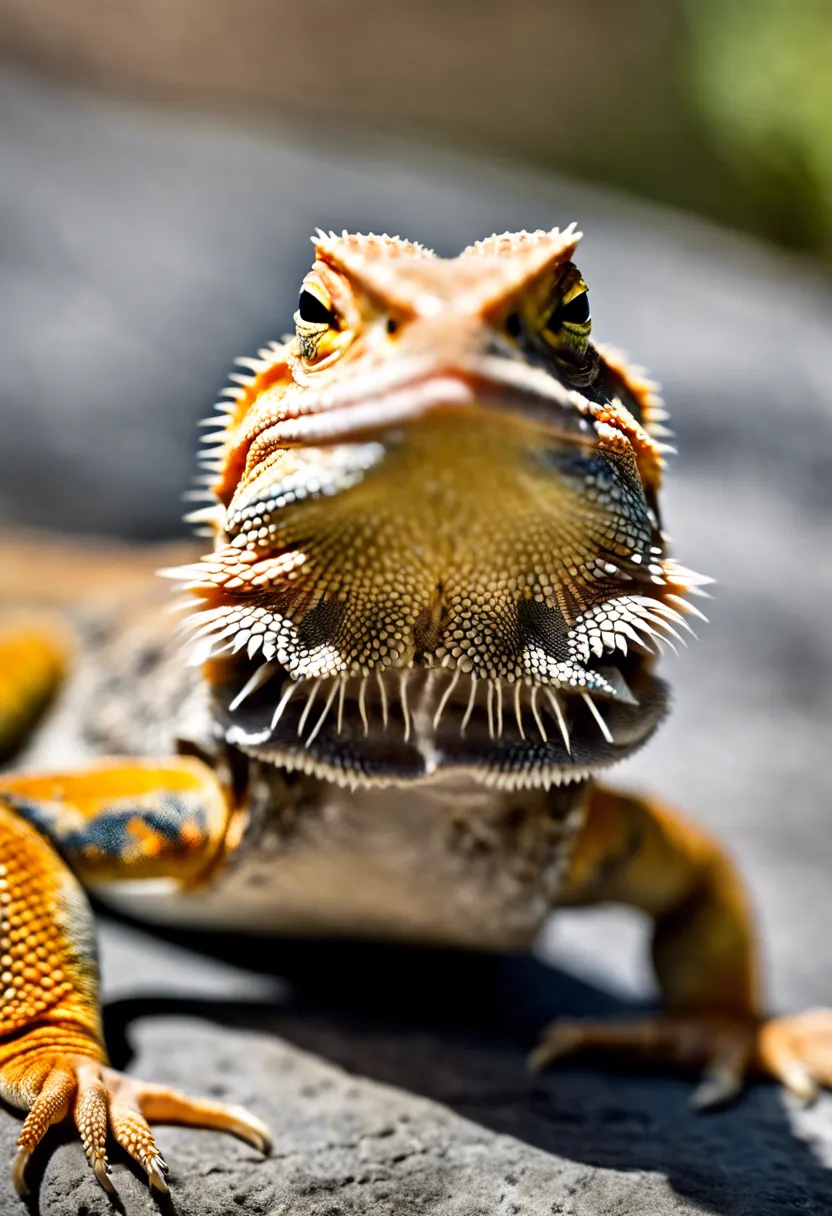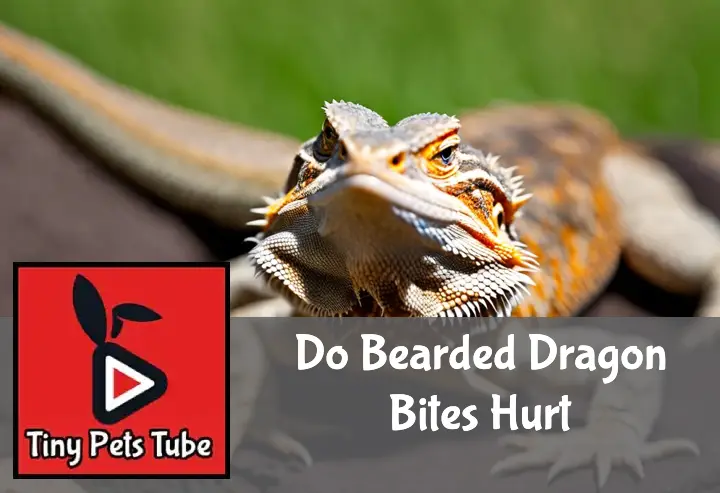Ever found yourself staring at a bearded dragon and wondering, “Do Bearded Dragon Bites Hurt?” Well, mate, you’ve just stumbled upon the right place. Now, before we dive into the nitty-gritty of beardie bites, let’s first get to know these fascinating creatures a bit better.
Bearded dragons, or ‘beardies’ as we like to call them in the reptile world, are generally easy-going creatures. But don’t let their chill demeanor fool you; they’ve got quite the chompers on them! Keep reading about Do Bearded Dragon Bites Hurt?
Key Takeaways
- Bearded dragon bites can cause discomfort but are not typically painful due to their small, blunt teeth.
- The level of pain experienced can depend on the size and age of the bearded dragon.
- Bites from a larger, adult bearded dragon may cause minor injuries like scratches or shallow cuts.
- Infections from bites are rare but possible if not properly cleaned and treated.
- Aggressive behavior leading to biting is usually a sign of stress or fear in the bearded dragon.

Understanding Bearded Dragons
Bearded dragons are fascinating creatures, often chosen as pets for their unique blend of physical characteristics and relatively easy care requirements. These exotic pets bring a slice of the wild into your home, combining intriguing bearded dragon facts with the practicalities of exotic pets care.
Characteristics of Bearded Dragons
When it comes to bearded dragon size, these critters can grow up to 24 inches long, including their tail, making them a manageable size for most pet owners. Their color variations in reptiles are another draw, ranging from sandy hues to striking oranges and reds, depending on factors like genetics and temperature.
The distinctive beard appearance, which can puff out and darken when they’re stressed or trying to show dominance, is where bearded dragons get their name. This feature, along with their spiky-looking yet soft reptile skin texture, makes them one of the most recognizable pet lizard features among reptile enthusiasts.
Behavior and Temperament of Bearded Dragons
Bearded dragons are known for their docile reptiles behavior, making them excellent companions for both novice and experienced reptile owners. They enjoy basking in the warmth during the day and are generally amiable creatures that tolerate handling well.
However, understanding their temperament involves recognizing stress signs in bearded dragons, such as excessive hiding or aggression. These signs can indicate that something is off in their environment or health. Being aware of potential aggression triggers in pets, like sudden movements or overcrowded terrariums, helps in preventing negative interactions.
Their capacity for social behavior with humans is remarkable among lizards. With proper handling and care, they can form a bond with their owners, showing how deep an understanding of lizard temperament can enhance the pet-keeping experience.
Do Bearded Dragon Bites Hurt?
When it comes to bearded dragon bite pain, many folks wonder if these seemingly chill reptile pals can pack a punch with their bites. Let’s dive into the nitty-gritty.
Physical Impact of a Bearded Dragon Bite
First off, when a bearded dragon decides to chomp down, you might feel a quick pinch or pressure more than anything else. Their bearded dragon teeth are designed more for crushing insects than causing serious harm to humans. However, don’t underestimate them; a skin puncture by lizard is totally possible, especially if they’re feeling particularly threatened or are not accustomed to being handled.
In most cases, the immediate sensation might be surprising rather than painful. But here’s where things get a bit dicey – infection from reptile bites is no joke. These little guys can carry bacteria in their mouths that could lead to an infection if the wound isn’t treated properly. So, treating bearded dragon bites with proper wound care and cleanliness is crucial.
Lastly, while lizard bite marks usually aren’t too severe, they can certainly leave a mark (pun intended). It’s rare but possible that you might need medical attention if the bite becomes infected or if you have an unusual reaction.
Psychological Impact of a Bearded Dragon Bite
Now onto the mind game part of getting nipped by your scaly friend. It’s not uncommon for owners to experience some fear of reptiles after bite incidents. This emotional response to pet bites can stir up quite the internal turmoil, making future handling sessions anxiety-inducing.
For some, trust issues with bearded dragons may develop, leading them to second-guess their ability to safely interact with their pet post-bite. It’s like walking on eggshells every time you reach into their habitat – not fun for you or your beardie.
But here’s the silver lining: overcoming fear of lizard bites is entirely possible with patience and understanding of your pet’s behavior. Remembering that most bites occur out of fear or discomfort rather than aggression can help rebuild confidence in both yourself and your scaled companion.
The psychological effects of animal bites shouldn’t be underestimated; they can linger long after physical wounds have healed. Yet with time and positive experiences, trust can be restored, ensuring that both you and your bearded dragon enjoy each other’s company once again.

Why Do Bearded Dragons Bite?

Understanding why a bearded dragon might decide to chomp down can help you prevent those not-so-pleasant surprises. It’s all about getting the lowdown on bearded dragon behavior and figuring out what ticks them off or scares them.
Defensive Biting in Bearded Dragons
Ever wondered why your chill pet lizard suddenly turns into a tiny dinosaur? Well, defensive biting is usually the culprit behind such surprising behavior. Bearded dragons, like any creature, have their boundaries. When they feel threatened or cornered, they might resort to biting as a last-ditch effort to say “back off!” Recognizing when your scaly buddy feels scared is key to avoiding these situations.
Look out for signs of stress in reptiles, such as puffing up their beard, hissing, or trying to escape. These are clear indicators that your bearded dragon is not having a good time. By interpreting lizard body language and reducing pet aggression through gentle handling and respect for their space, you can foster a more harmonious relationship with your reptilian pal.
Accidental Biting During Feeding
Now onto the less aggressive but equally surprising accidental bites during feeding times. Ever been mistaken for a juicy cricket? Your bearded dragon might just think your fingers are on the menu if you’re not careful! This mix-up usually happens due to overexcitement or poor aim rather than any real appetite for human fingers.
To keep feeding times peaceful and pain-free, adopt safe reptile feeding techniques like using tweezers or placing food directly into their dish rather than hand-feeding. This minimizes the risk of those little teeth catching you instead of their lunch. Remember, preventing accidental bites is all about understanding and respecting your bearded dragon’s dining habits while keeping those digits out of harm’s way!
How to Prevent Bites from Your Bearded Dragon
Understanding and respecting your bearded dragon’s behavior is key to preventing bites. Proper handling techniques and recognizing warning signs are essential.
Proper Handling Techniques for Bearded Dragons
When it comes to safe lizard handling, patience is your best friend. Start by letting your bearded buddy get used to your presence. Hang around their habitat without making any sudden moves. This helps in building trust with bearded dragons. Once they seem comfortable with you being there, you can gently place your hand in the enclosure, still not touching them, just letting them acknowledge that your hand is not a threat.
The next step involves gentle handling of pets. When you do pick them up, ensure it’s done softly, supporting their entire body. Avoid grabbing them from above as this can trigger their predator response. Instead, slide your hand under their belly and lift gently. It’s all about reading reptile body language here; if they seem tense or try to squirm away, give them some space.
Signs That Your Beared Dragon May Bite
Recognizing the warning signs of lizard bites is crucial for any pet owner. One clear sign is a change in their body posture; if they puff up or flatten out, they’re trying to appear bigger – a classic defensive behavior. Another indicator could be hissing or opening their mouth wide open as if they’re ready to clamp down on something.
Moreover, interpreting bearded dragon behaviors like sudden changes in coloration can also hint at stress or aggression. If you notice darker coloration especially around the beard area, it might be time to back off and give them some space. These are all part of understanding reptile warning signals which can go a long way in preventing pet lizard bites.
What to Do If You Get Bit by a Bearded Dragon?
Getting nipped by your scaly buddy isn’t on anyone’s bucket list. But if it happens, knowing bearded dragon bite care is crucial.
Immediate First Aid Steps
First things first, don’t panic. A bearded dragon bite might surprise you, but they’re rarely serious. Start by gently washing the wound with soap and water to prevent infection. This step is all about cleaning a reptile bite wound thoroughly.
Next up, apply some pressure if there’s bleeding. Most bites from these critters are more shock than damage, so stopping any minor bleeding shouldn’t be too tough. After that, dabbing on some antiseptic cream is your go-to move for disinfecting a bearded dragon bite.
Keep an eye on the bite area over the next few days for any signs of change. Having a first aid kit for pet owners handy can make this whole process smoother and quicker.
When to Seek Medical Attention
Now, let’s talk about when to escalate things. If you notice redness spreading around the bite or if it becomes swollen and painful, these could be symptoms of infected animal bites, and it’s time to call in the pros.
Feeling feverish or noticing unusual warmth around the wound? These are also red flags signaling that professional wound care might be needed. And let’s not forget about tetanus – if you haven’t had a shot in the last 10 years, visiting a doctor should be on your agenda.
Lastly, allergic reactions are rare but possible. Symptoms like difficulty breathing or swelling beyond the bite site mean you should seek emergency services pronto. Remember, better safe than sorry when dealing with potential complications from animal bites!

To Wrap Up
So, Do Bearded Dragon Bites Hurt? Well, it’s like getting a surprise pinch from a mischievous toddler – unexpected but not unbearable.
Remember to treat your scaly buddy with respect and patience. After all, communication is key, even if it involves some harmless nipping!


